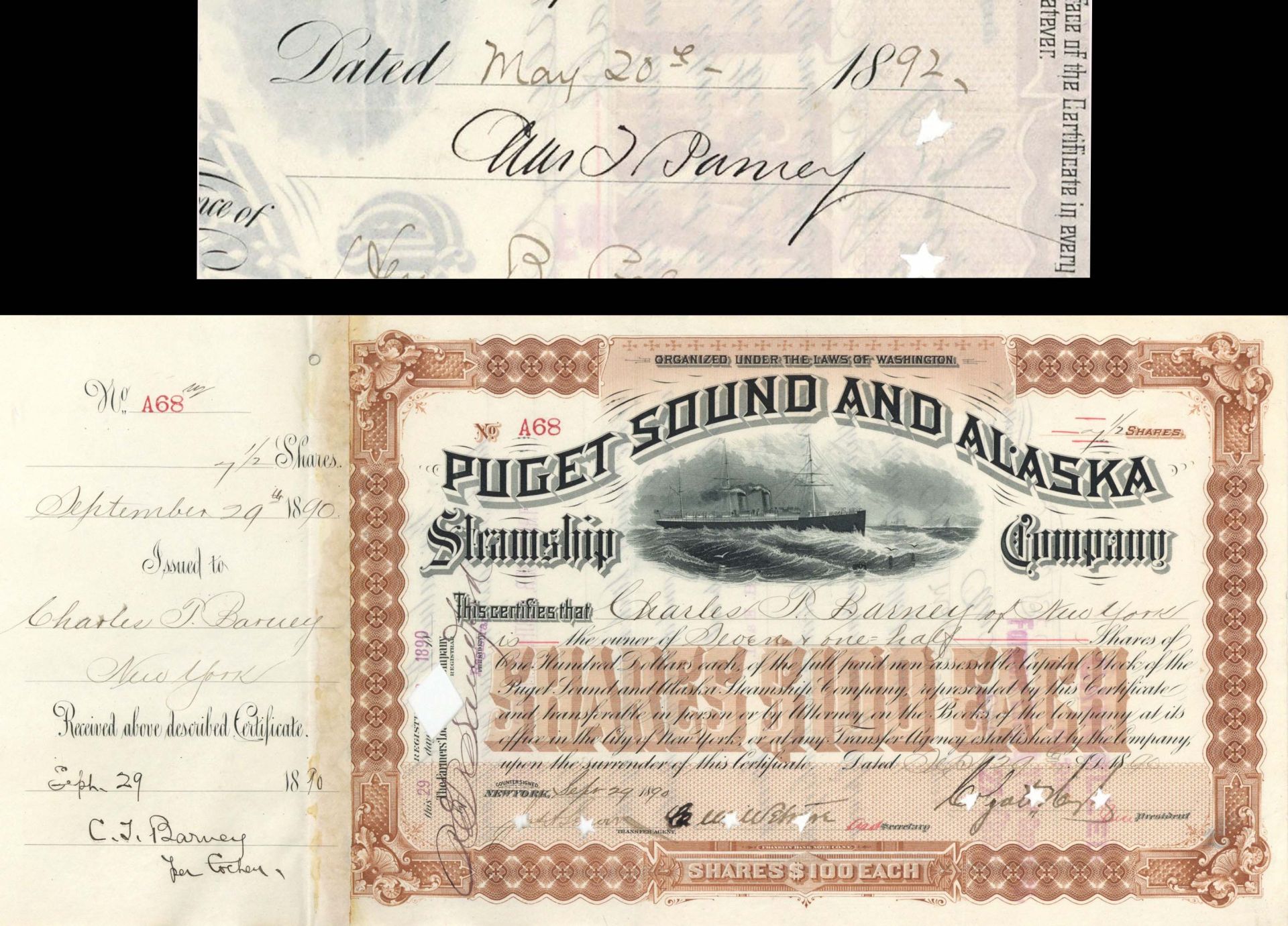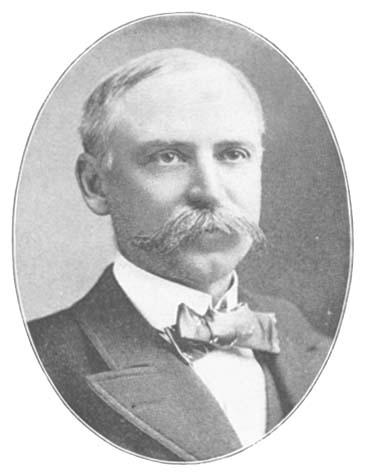Puget Sound and Alaska Steamship Co. issued to and signed by Charles T. Barney - Stock Certificate
Inv# AG2285 Stock
Stock issued to Charles T. Barney and signed on back. Also signed by Colgate Hoyt as president.
_(18243477430).jpg)
Charles Tracy Barney (1851-1907) was born in Cleveland, Ohio, the son of Ashbel H. Barney and Susan (Tracy) Barney. His father was a successful forwarding and commission merchant. In 1857 the family moved to New York City, where Ashbel Barney was a director, vice president, and president of Wells Fargo & Company.
Barney attended Williams College in Williamstown, Mass., graduating in 1870. Following graduation he moved to New York and entered banking. He married Lucy Collins "Lily" Whitney, the sister of William Collins Whitney, the patriarch of the Whitney family. Charles Tracy Barney was the president of the Knickerbocker Trust Company, the collapse of which shortly before Barney's death sparked the Panic of 1907.
Barney himself was not ruined financially. Despite his resignation he still had an estimated $2.5 million in assets over and above liabilities. But personally he was disgraced. On the morning of November 14, Barney was in his bedroom on the second floor of the house, with two windows facing 38th Street. He was accustomed to eat breakfast here and then conduct business by telephone before dressing in late morning. On this particular morning, Lily Barney and Mrs. Susan Abbott Mead, a guest who had arrived from Europe two weeks before, were in Lily's adjoining bedroom. Shortly before 10:00 a.m. they heard a shot fired in Barney's room. Mrs. Mead ran into the room and saw Mr. Barney standing. Mrs. Mead called to Lily Barney, who ran into the room. As she approached her husband, he fell to the floor and she cradled his head in her lap. Ashbel H. Barney II, who had heard the shot on the first floor, thereupon entered the room. Barney told his son, "Don't move me."
Barney had shot himself in the abdomen with a .32 cal. revolver. Lily Barney later told Coroner Harburger that pistols were kept on every floor of the house for protection. Medical assistance was summoned, and in the meantime Barney made and signed arrangements for the disposal of his affairs in addition to his existing will. Then, still in his home, he underwent exploratory surgery at the hands of Dr. Joseph A. Blake and the family's physician, Dr. George A. Dixon. Barney died at 2:30 p.m. while still under anaesthesia.
Barney's funeral was conducted at the residence on November 16, 1907, by the Rev. Dr. Charles H. Parkhurst of the Madison Square Presbyterian Church. Some 40 persons were present for the private service, among them Barney's widow and their two daughters and one son (the other was in Europe). Also present were Harry Payne Whitney, Henry Melville Whitney, Joseph S. Auerbach, Dr. George A. Dixon and Barney's lawyers, George L. Nichols and Arthur H. Masten. Following the service, the hearse took Barney's body to Grand Central Station, from whence a special train took it to Woodlawn Cemetery. Parkhurst said a prayer at the graveside.

Colgate Hoyt (1849-1922), banker, born in Cleveland, Ohio, March 2, 1849, is a son of James M. Hoyt, a lawyer and man of high position. The young man attended Phillips Academy, Andover, but, owing to the failure of his sight, left school at the end of the first year. He then secured a place in a hardware store in Cleveland, rose by his own merit, and finally joined his father in real estate operations, becoming himself the owner of desirable properties. During 1877-81, he engaged in loans of money on real estate security. In May, 1881, he removed to New York City to become a partner in the banking and bullion firm of J. B. Colgate & Co. He made his way here with marked success and remained an active member until the death of Mr. Trevor, in 1890. Banking soon led him into intimate relations with large corporations. A government director of The Union Pacific Railroad, 1882-84, he was thereafter a company director but resigned several years later. In 1884, he joined Charles L. Colby and Edwin H. Abbott in The Wisconsin Central Railroad enterprise, these three men becoming trustees of the entire stock of the corporation, and building a road to St. Paul and one from near Milwaukee to Chicago, thus making The Wisconsin Central a through line from Chicago to St. Paul and Milwaukee. They also built The Chicago & Northern Pacific Railroad as a terminal, with splendid passenger stations in Chicago. Mr. Hoyt has also been a director and active spirit in The Oregon Railway & Navigation Co., The Northern Pacific Railroad, and The Oregon & Transcontinental Co., and in 1890 reorganized the latter as The North America Co., with entire success, and under trying circumstances. The American Steel Barge Co., whose shipyard and docks are at West Superior, Wisconsin, is the creation of Mr. Hoyt, who bought the whaleback patents of Capt. Alex. McDougall in 1888, organized the company with a capital $500,000, becoming its president and treasurer, and has since employed about 1,500 men and constructed about thirty whalebacks and other vessels of importance. Another of his enterprises is The Spanish-American Iron Co., of which he is an organizer and treasurer, which, with a capital of $5,000,000, is working the Lola group of iron mines in Cuba.
Mr. Hoyt was prominent socially, and was a member of the Metropolitan, Union League, Lawyers’, Riding, Fencers’, Country, Oyster Bay Yacht, Larchmont Yacht and Seawanhaka Corinthian Yacht clubs, and The Ohio Socity. In 1873, he married Lida W. Sherman, daughter of Judge Charles T. Sherman, and a niece of Gen. William T. Sherman. They have four children living.
A stock certificate is issued by businesses, usually companies. A stock is part of the permanent finance of a business. Normally, they are never repaid, and the investor can recover his/her money only by selling to another investor. Most stocks, or also called shares, earn dividends, at the business's discretion, depending on how well it has traded. A stockholder or shareholder is a part-owner of the business that issued the stock certificates.









Ebay ID: labarre_galleries